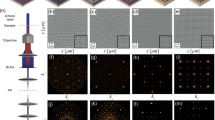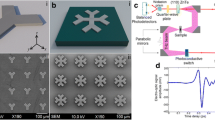Abstract
The ability to precisely tailor lineshapes, operational bandwidth, and localized electromagnetic field enhancements (“hot spots”) in nanostructures is currently of interest in advancing the performance of plasmonics-based chemical and biological sensing techniques. Fractal geometries are an intriguing alternative in the design of plasmonic nanostructures as they offer tunable multiband response spanning the visible and infrared spectral regions. A numerical study of the optical behavior of ternary tree fractal plasmonic nanoantenna is presented. Self-similar features are seen to emerge in the extinction spectra with the increase in fractal order N of the tree structure. Plasmon oscillations occurring at different length scales are shown to correspond to the multiple peaks and are compared with the spatial maps of electric field enhancement at the surface of the nanoantenna. The multiple peaks are shown to be independently tunable by structural variation. The robustness of the spectral response and polarization dependence arising due to various asymmetries is discussed.






Similar content being viewed by others
References
Maier SA (2007) Plasmonics: fundamentals and applications. Springer
Ciraci C, Hill RT, Mock JJ, Urzhumov Y, Fernandez-Dominguez aI, Maier Sa, Pendry JB, Chilkoti A, Smith DR (2012) Probing the ultimate limits of plasmonic enhancement. Science 337(6098):1072–1074
Anker JN, Hall WP, Lyandres O, Shah NC, Zhao J, Van Duyne RP (2008) Biosensing with plasmonic nanosensors. Nat Mater 7(6):442–453
Moskovic M, Kneipp K (2006) Surface-enhanced raman scattering physics and applications. Springer
Jackson JB, Halas NJ (2004) Surface-enhanced Raman scattering on tunable plasmonic nanoparticle substrates. Proc Natl Acad Sci U S A 101(52):17,930–17,935
Kundu J, Le F, Nordlander P, Halas NJ (2008) Surface enhanced infrared absorption (SEIRA) spectroscopy on nanoshell aggregate substrates. Chem Phys Lett 452(1-3):115–119
Scalora M, Vincenti MA, de Ceglia D, Roppo V, Centini M, Akozbek N, Bloemer MJ (2010) Second and third harmonic generation in metal-based nanostructures. Phys Rev A 82:043828
Song Z, Zhang B (2014) Wide-angle polarization-insensitive transparency of a continuous opaque metal film for near- infrared light. Opt Exp 22(6):6519–6525
Song Z, He Q, Xiao S, Zhou L (2012) Making a continuous metal film transparent via scattering cancellations. Appl Phys Lett 101(18):1–5
Gallinet B, Martin OJF (2011) Influence of electromagnetic interactions on the line shape of plasmonic fano resonances. ACS Nano 5(11):8999–9008
Becker J, Trügler A, Jakab A, Hohenester U, Sönnichsen C (2010) The optimal aspect ratio of gold nanorods for plasmonic bio-sensing. Plasmonics 5(2):161–167
Hegde RS, Mesch M, Giessen H (2014) Perturbation theory for the optimal design of plasmon induced transparency based sensors. In: META’15, Fifth International Conference on Metamaterials, Photonic Crystals and Plasmonics, Singapore
Liu Y, Pedireddy S, Lee YH, Hegde RS, Tjiu WW, Cui Y, Ling XY (2014) Precision synthesis: designing hot spots over hot spots via selective gold deposition on silver octahedra edges. Small 10(23):4940–4950
Gottheim S, Zhang H, Govorov AO, Halas NJ (2015) Fractal nanoparticle plasmonics: the Cayley Tree. ACS Nano (August):150310091547, 007
Luk’yanchuk B, Zheludev NI, Maier Sa, Halas NJ, Nordlander P, Giessen H, Chong CT (2010) The Fano resonance in plasmonic nanostructures and metamaterials. Nat Mater 9(9):707–715
Brolo AG, Gordon R, Leathem B, Kavanagh KL (2004) Surface plasmon sensor based on the enhanced light transmission through arrays of nanoholes in gold films. Langmuir : The ACS Journal of Surfaces and Colloids 20(12):4813–4815
Hayashi S (1985) SERS on random rough silver surfaces: evidence of surface plasmon excitation and the enhancement factor for copper phthalocyanine. Surf Sci 158(1-3):229–237
Luchowski R, Shtoyko T, Matveeva E, Sarkar P, Borejdo J, Gryczynski Z, Gryczynski I (2010) Molecular fluorescence enhancement on fractal-like structures. Appl Spectrosc 64(6):578–583
Dong J, Qu S, Zheng H, Zhang Z, Li J, Huo Y, Li G (2014) Simultaneous SEF and SERRS from silver fractal-like nanostructure. Sens Actuators B Chem 191:595–599
Stockman MI, Shalaev VM, Moskovits M, Botet R, George TF (1992) Enhanced {Raman} scattering by fractal clusters: scale invariant theory. Phys Rev B 46:2821–2830
Werner DH, Haupt RL, Werner PL (1999) Fractal antenna engineering: the theory and design of fractal antenna arrays. IEEE Antennas Propag Mag 41(5):37–59
Zhou L, Chan CT, Sheng P (2004) Theoretical studies on the transmission and reflection properties of metallic planar fractals. J Phys D Appl Phys 37(3):368–373
Wen W, Zhou L, Li J, Ge W, Chan CT, Sheng P (2002) Subwavelength photonic band gaps from planar fractals. Physical review letters 89(22):223,901
Sederberg S, Elezzabi AY (2011) Sierpiski fractal plasmonic antenna: a fractal abstraction of the plasmonic bowtie antenna. Opt Express 19(11):10,456–10,461
Chen Y, Zhan L, Wu J, Wang T (2014) Polarization anisotropic transmission through metallic Sierpinski-Carpet aperture array. Opt Express 22(3):2222
Volpe G, Volpe G, Quidant R (2011) Fractal plasmonics: subdiffraction focusing and broadband spectral response by a Sierpinski nanocarpet. Opt Express 19(4):3612–3618
Chen TL, Dikken DJ, Prangsma JC, Segerink F, Herek JL (2014) Characterization of Sierpinski carpet optical antenna at visible and near-infrared wavelengths. New J Phys 16(9):093,024
Zhu LH, Shao MR, Peng RW, Fan RH, Huang XR, Wang M (2013) Broadband absorption and efficiency enhancement of an ultra-thin silicon solar cell with a plasmonic fractal. Opt Express 21 Suppl 3 (May):A313—23
Nagatani T (1989) Growth model with phase transition: drift-diffusion-limited aggregation. Phys Rev A 39:438–441
Johnson PB, Christy RW, Johnson PB, Christy RW (1972) Optical constants of the noble metals
Kuttge M, García De Abajo FJ, Polman A (2010) Ultrasmall mode volume plasmonic nanodisk resonators. Nano Lett 10(5):1537–1541
Willingham B, Brandl DW, Nordlander P (2008) Plasmon hybridization in nanorod dimers. Appl Phys B Lasers Opt 93(1):209–216
Funston AM, Novo C, Davis TJ, Mulvaney P (2009) Plasmon coupling of gold nanorods at short distances and in different geometries. Nano Lett 9(4):1651–1658
Knight MW, Wu Y, Lassiter JB, Nordlander P, Halas NJ (2009) Substrates matter: influence of an adjacent dielectric on an individual plasmonic nanoparticle. Nano Lett 9(5):2188–2192
Powell DA, Kivshar YS (2010) Substrate-induced bianisotropy in metamaterials. Appl Phys Lett 97:091106
Zhang S, Bao K, Halas NJ, Xu H, Nordlander P (2011) Substrate-induced Fano resonances of a plasmonic nanocube: a route to increased-sensitivity localized surface plasmon resonance sensors revealed. Nano Lett 11(4):1657–1663
Cui Y, Phang IY, Hegde RS, Lee YH, Ling XY (2014) Plasmonic silver nanowire structures for two-dimensional multiple-digit molecular data storage application. ACS Photon 1(7):631–637
Cui Y, Hegde RS, Phang IY, Lee HK, Ling XY (2014) Encoding molecular information in plasmonic nanostructures for anti-counterfeiting applications. Nanoscale 6(1):282–288
Maier SA (2006) Plasmonic field enhancement and SERS in the effective mode volume picture. Opt Express 14(5):1957–1964
Agrawal A, Matsui T, Zhu W, Nahata A, Vardeny ZV (2009) Terahertz spectroscopy of plasmonic fractals. Phys Rev Lett 102:113,901
Author information
Authors and Affiliations
Corresponding author
Rights and permissions
About this article
Cite this article
Hegde, R.S., Khoo, E.H. Broadband Optical Response in Ternary Tree Fractal Plasmonic Nanoantenna. Plasmonics 11, 465–473 (2016). https://doi.org/10.1007/s11468-015-0059-3
Received:
Accepted:
Published:
Issue Date:
DOI: https://doi.org/10.1007/s11468-015-0059-3




